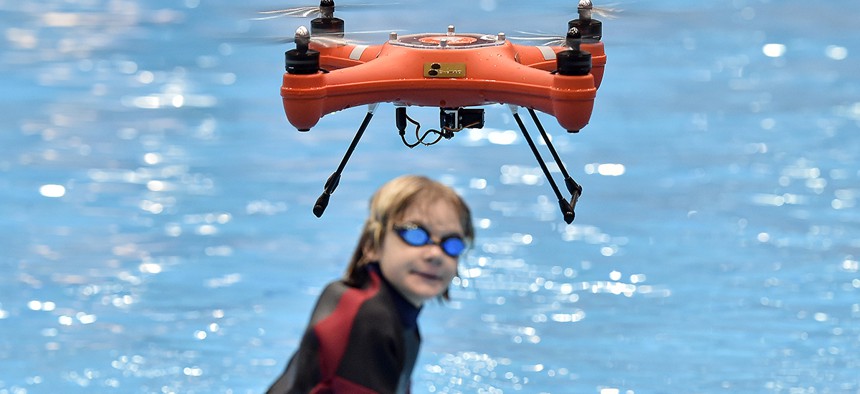Why We Should Call in the Drones When There’s an Emergency

A water drone demonstrates maritime salvage by flying a lifesaver to a boy in the water, at the world's largest watersports trade fair BOOT in Duesseldorf, Germany, Friday, Jan. 22, 2016. Martin Meissner/AP
A small drone couldn’t take someone to the hospital, but might be able to bring a virtual medic to assess the situation.
John Breeden II is an award-winning journalist and reviewer with over 20 years of experience covering technology and government. He is currently the CEO of the Tech Writers Bureau, a group that creates technological thought leadership content for organizations of all sizes. Twitter: @LabGuys
Hopefully, by the time anyone reads this, the streets surrounding every home and agency will have been completely cleared of snow. With the recent higher temperatures, even those shoved-aside mountains of the soggy white stuff blocking sidewalks and pedestrian crossings have started to sag. The Washington region is slowly getting back to normal.
But during the height of the storm and for several days afterward, many places were as inaccessible as my own neighborhood. I was able to clear my driveway as well as my elderly neighbor’s house after the snow stopped – but with the roads totally blocked nobody could actually get anywhere. It was fun to be able to camp at home for a while – especially since we, thankfully, never lost power – but I worried about access to emergency vehicles should the need arise.
With the roads blocked, one solution might have been the use of Small Unmanned Aerial Systems, or sUAS, also sometimes called drones. The use of small drones has taken center stage in some industries such as retail and oil and gas. But drones would also be a natural fit for emergency services.
Think about it like this: A small drone couldn’t take someone to the hospital, but could bring a virtual medic to assess the situation. Likewise, in the event of a reported fire, a drone could quickly perform reconnaissance to see how much equipment would be needed to fight it, and the condition of the roads leading there.
Some states are starting to embrace this concept. Utah's emergency management agency is starting to explore using drones to bolster search and rescue services. And it’s not just a matter of having the fire department own a drone.
In Utah, they are tapping into the huge drone hobbyist community by giving them the tools and training needed to help report information to first responders. Now, when someone gets lost in the vastness that makes up Utah, a fleet of private drones can be launched to bolster search efforts.
Besides being extremely efficient, using the drone-flying community is extremely cheap compared to other options.
"If you were to use a helicopter, say a National Guard Blackhawk helicopter for firefighting operations, that costs about $4,000 an hour,” Joe Dougherty, a spokesman from the Utah Department of Emergency Management, told the Salt Lake City Fox affiliate in October.
Compared to the free and willing volunteer air force, that is quite a difference. Perhaps the state of Utah can buy pizza for the drone pilots after a successful rescue operation. My guess is that they would be really happy with a reward like that.
Contrast what is happening in Utah to the draconian policies the Federal Aviation Administration has levied on Washington, D.C.’s drone community. Believe it or not, the agency has imposed a 30-mile no-fly zone surrounding D.C. and all cities and towns within a 30-mile radius of Ronald Reagan Washington National Airport. They even provide a helpful page full of printable signs and stickers declaring the area a “No Drone Zone.”
I realize Washington is a special city because the president lives here. But come on, someone flying a drone in a park in Fairfax is not a threat. I suppose fire and rescue companies could be given exceptions to that rule, but regardless, it still locks out any auxiliary help from hobbyists looking to protect their communities and lend a hand.
In Germantown, where I live, we are thankfully just outside the current no-fly regulations. While there is no interface with the fire department yet, one neighbor used his drone to blast the blizzard’s remains from his roof by hovering nearby and pushing the snow aside using the downdraft.
Over the summer, many people fly their drones in the local parks. I really enjoy watching them and am considering getting one of my own. If I do, I would love to join some sort of a community auxiliary and do whatever I could to help fire and rescue companies. I think most drone-flying hobbyists probably feel the same way.






